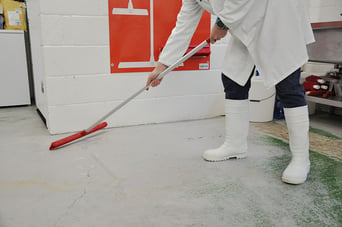If you thought a brush is a brush, when it comes to floorcare, then think again. Adrian Peck, Business Development Manager from Hillbrush looks at the importance of choosing the right brush for the job, floor type and the correct techniques to save time and money.

“For most people, a brush is simply a tool to do a job, but don’t underestimate its capability or importance. This is particularly true when it comes to cleaning protocols for high-risk areas such as food manufacturing sites. Choosing, using, and maintaining cleaning equipment and systems are essential for minimising the risk of microbial, allergen, and foreign body cross-contamination and, in turn, compliance to a range of regulatory requirements, food safety hazard management systems such as HACCP, as well as external accreditations such as BRC and individual customer audits.
For contract cleaners working in these environments using the right brushes for the job is essential. Plastic, food approved cleaning tools have to be used to minimise the risk of cross contamination and comply with food regulations. Floorcare often requires cleaning over large surface areas with cleaning equipment collecting and spreading pathogen contamination. Not only is it essential therefore to ensure that the correct equipment is selected but that it is used, cleaned, stored and maintained correctly.
So, what type of brush to use for cleaning hard floors? It should not be a question of picking any brush but careful consideration of the selection of tools suitable for the task. Stiffness and length of filaments, brush materials and the type of soils to be removed should be considered. Investing in a cleaning audit from a brush supplier can help with selecting brushes and training can help with ensuring that it is used correctly.
There are many different types of brush fibre which have varying cleaning qualities as well as ranging from stiff to soft. The type of brush to choose depends on the job that the cleaner is undertaking. A stiff brush for example should be used to agitate and remove. A tough brush fibre can be used to remove residues such as wet flour for example that has been trodden into the floor. Use of a stiff brush with the correct chemicals and manual labour, rather than a jet wash cleaner, will minimise the risk of debris spreading to a wider area.
In contrast, a soft brush should be used to ‘sweep and gather’ on a less smooth surface and is ideal for once a stiff brush has been used to remove hardened debris. Brushes and brooms with flagged fibres should not be use in dry food production areas such as bakeries since loose fibres can pose a risk of foreign body contamination. Food processors should choose brushes with extra soft or crimped plastic filaments to ensure filament retention.

Selecting the right cleaning tool for floorcare is just the start. Using a brush correctly is essential to ensure the maximum amount of sweep. Holding the broom at the right angle with the right length handle for your stature will mean that all the fibres – five rows of fibre filaments in the case of Hillbrush brushes – are in contact with the floor. Cheaper cleaning tools do not have the same ‘sweepability’ and require much more time to get the job done. A good example is with a floor squeegee used for washing down at the end of a production shift. A washdown will result in listeria which requires careful cleaning with a squeegee and correct chemicals. If the squeegee is well maintained and used correctly it should sit flush with the ground, with the water removed easily with a few bold sweeps.
Old or faulty cleaning tools, and incorrect cleaning and storage of tools are all key factors contributing to potential microbiological hazards. Floor cleaning should reduce the risk of bacteria, not contribute to the loading on equipment and the environment.